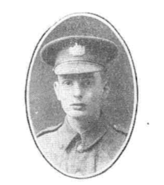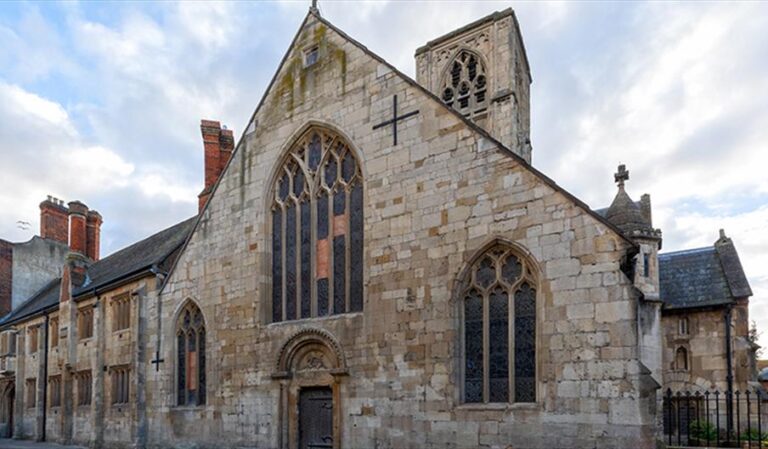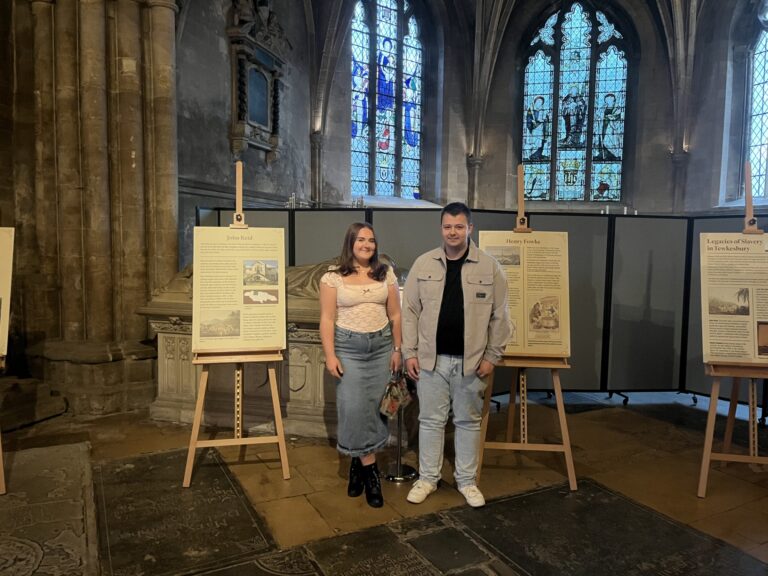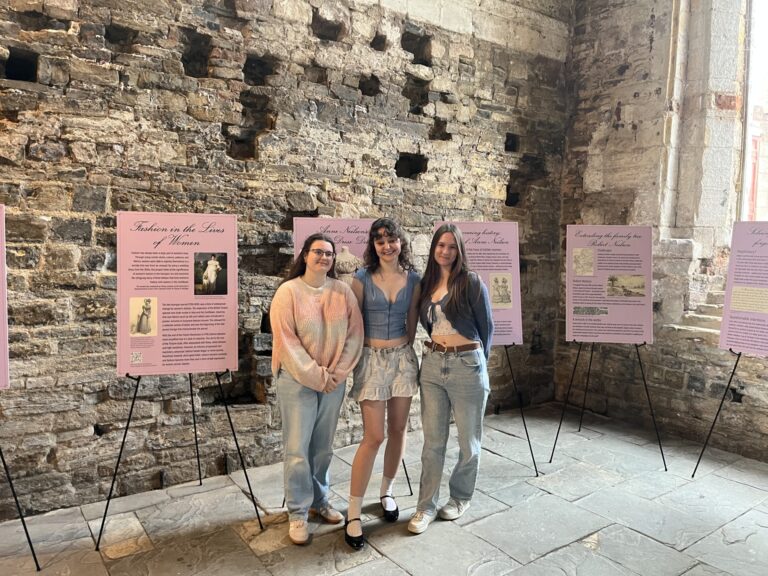| CC4HH
The Centenary of the End of WW1: the impact/legacy of the Great War in Cheltenham
This project was conducted by Rebecca Humphrey, Rhian James, Lily Lord, Bertie Lyman.
Our group examined the centenary of the end of World War One and its impact on the local area in Cheltenham, making use of materials available in local archives.
Jump to: Timeline | Case studies | Cheltenham Racecourse VAD Hospital | H.H. Martyn | Munitions strike | Memorial
Timeline marking Britain’s key involvements in WW1
28 June 1914 – Franz Ferdinand Assassinated, Austria declares war on Serbia
1-3 August 1914 – Germany declares war on Russia / France
4 August 1914 – Britain declares war
December 1914 – First Zeppelins appear
February 1915 – Churchill resigns – Rejoins as a commander
July – November 1916 – Battle of the Somme – 420,000 British Soldiers killed
6 April 1917 – USA declares war on Germany
April 1918 – RAF formed
9 November 1918 – Kaiser abdicates
11 November 1918 – Armistice signed
Case studies of soldiers: How did WW1 Impact local people in Cheltenham
Sergeant Frederick Ewart Bridgman
Frederick Bridgman, from Larput Place, died in action on the 25 September 1915 aged 20. He lived near his old school, St Paul’s. On Saturday 9 October 1915, an article in the Cheltenham Chronicle stated that Bridgman ‘enlisted in September 1914, and his general smartness and strict devotion to duty won him an early promotion’. Bridgman was amongst the first boys from St Paul’s school to enlist.
‘Just a line to let you know that I found this little photo (of a young woman) on a dead body 26th September, 1915, which is that of Sergt F E Bridgman… I am sorry to say he lay by a trench that the 10th Battalion took and from what I can see he was one of the first to get to the enemy trench’. – ‘War Notes: Casualties in the Rank and File,’ Cheltenham Chronicle, 9 October 1915, p. 6

William Pontin
Lance Corporal Pontin was just 24 years old when he was killed on 31 March 1918, only 8 months before the end of the war. William was a prominent member of the St Paul’s community as a member of the Scouts and the choir.

Frank Driscoll
Frank Driscoll lost his life at the Battle of Loos on the 25 September 1915 as a member of the 10th Gloucester’s regiment. His death was recorded in the local newspaper, where he was listed as a foreman at ‘Messrs Bailey and Co.’
These three soldiers were pupils of St Paul’s school. All of the pupils at St Paul’s were local children. If a group of former pupils went to war together, the impact on the local area would be significant. Most of the St Paul’s boys were members of the ‘10th Gloucester’s’.
For the soldiers, it may have been comforting to be away with friends and people they knew, but it was a difficult time for those left at home.

Do you know any soldier’s stories from the war?
What do their experiences reveal?
Cheltenham Racecourse VAD Hospital
The Voluntary Aid Detachment (VAD) set up hospitals with the aid of the Red Cross during the war and these were run predominantly by civilians from the local area. The railway line and a vast number of large houses meant that Cheltenham was an ideal location to set up hospitals. There were eight VAD hospitals in Cheltenham and these treated around 15,812 people.
A number of different nationalities were treated at the hospitals: British, Belgian, Australian and others.
he Racecourse VAD hospital was opened on the 28 October 1914. It had a total of 220 beds by 1918. The hospital received a total of 3169 admissions and treated British, Canadian, Australian, Belgian and American soldiers. When it was opened, the hospital lacked basic amenities. Miss Ratcliffe, the Commandant, complained that there was no heating, hot water or lights during the first winter. These issues were rectified in the coming months.
The hospital closed on 28 February 1919.

One Australian patient – Andrew William Stevens – tragically died at the hospital. While on his way to meet some friends, he fell and fractured his skull as he was trying to climb a fence on 18 November 1917. He died two days later.
Men lined the hospital grounds as Stevens’ body was carried away.
Five people received honours or mentions from the King for their services at the Racecourse hospital. Two women – Bridget Hands and Kate Ruby Peters – received the Royal Red Cross for their efforts.
Mary McClymont Reid was from Bishops Cleeve. She worked as a part-time nurse at the Racecourse hospital from November 1914 to February 1919 – as a volunteer. Mary was not paid, but she gave 9443 hours of volunteer work. Mary’s hard work earned her a mention in dispatches, and her photograph was published in the Cheltenham Chronicle and Gloucestershire Graphic on Saturday 28 December 1918.

H.H Martyn
Before World War One, Cheltenham company H.H. Martyn fitted out ocean liners and created ornamental artwork. They competed against the Marples furniture company and others for the prize of a contract with Aircraft Manufacturing Co. (Airco). In 1915, Martyn received a contract from Maurice Farman to create and build ammunition cases and fuselages for his aircrafts. Martyn’s also built most of the components for Airco’s DH2s and BE2s.
Women were employed at the factory. They cut, stitched, treated and fitted fabric onto the frames used to build the aircraft.
On 5 June 1917, Alfred Martyn and Hugh Burroughes established a business partnership to create what was to become the Gloster Aircraft Company. They built over 14 aircraft a week and moved part of their production rented space at the Winter Gardens. The company took great care of their employees. Women working in the dope section, where they were preparing wings, were given a medical check every 2 weeks and they received 1 pint of milk a day and an extra farthing per hour: £2 9s on day shifts; and £2 12s on night shifts. By June 1918, H.H. Martyn and GAC employed 780 people.

© John Whitaker

© Neela Mann

© John Whitaker
Strike!

On January 1916, 90 munitions workers from the Sunningend Works went on strike. During the war it was forbidden for any munitions workers to strike. To avoid prosecution, workers resigned and did not turn up to work the next Monday. Within a week the dispute was settled following a visit from a Ministry of Munitions official.
Image: Workers at the Winter Gardens.
© John Whitaker
The war is over




Cheltenham Chronicle and Gloucestershire Graphic published these photos on 23 November 1918 of workers from H.H. Martyn and GAC joining the procession that lined the streets of Cheltenham the day after the Armistice was signed. They carried with them pieces of the aircrafts they had built.
What would it feel like for a large business in your area suddenly to change purpose?
How would that effect employment in the area?
In Memoriam: Cheltenham memorialises the fallen
When the armistice was signed on the 11 November 1918, Cheltenham, along with the rest of the country, went into the streets and celebrated. Photographs from the Cheltenham Chronicle and Graphic show celebratory scenes along the promenade. For many, thoughts soon turned to memorialising the fallen. Of the estimated 7000 Cheltonian’s who fought in the conflict, 1600 did not return home.
When the armistice was signed on the 11 November 1918, Cheltenham, along with the rest of the country, went into the streets and celebrated. Photographs from the Cheltenham Chronicle and Graphic show celebratory scenes along the promenade. For many, thoughts soon turned to memorialising the fallen. Of the estimated 7000 Cheltonian’s who fought in the conflict, 1600 did not return home.

Memorialising
There are many memorials dedicated to the First World War in and around Cheltenham. Some were unveiled soon after the conflict. However, the task of creating a Cheltenham town memorial took a while longer, requiring the efforts of a dedicated committee.

Cheltenham War Memorial was unveiled over two years after the unveiling of the Bishops Cleeve war memorial in September 1919. Many designs were submitted for consideration, but only few of these survive to this day.
One of the earlier designs, published in the Cheltenham Chronicle and Graphic, proposed the demolition of a number of buildings in Clarence Street in order to place a war memorial in front of St Mary’s Church. This design would have drastically altered the landscape of today’s Cheltenham.
The Final Designs
A position on the promenade was agreed for the placement of the memorial. Three of the designs are pictured below. One, proposed by Col. J C Griffiths, was a replica of the Temple of Vista in Rome. Another, an impressive sculpture of an artillery man on horseback, created by the chief sculptor of Cheltenham company H.H. Martyn, Robert Lindsay Clark, was thought too partisan as well as proving too expensive. Neither design was used. The third design, submitted by R L Boulton and Sons, was selected. The ambitious design envisaged a cenotaph with a monolith on which names were to be inscribed, covered by a stone canopy supported by classical pillars.



Today’s Memorial

The memorial we see today on Cheltenham’s Promenade is not the ambitious design pictured above. The estimated £3,500 cost could not to be met in a post war climate of unemployment and miners’ strikes, despite a significant fundraising effort by the war memorial committee and appeals by the Mayor.
The eventual design was modelled on that of the London cenotaph. It was unveiled on the 1 October 1921.



